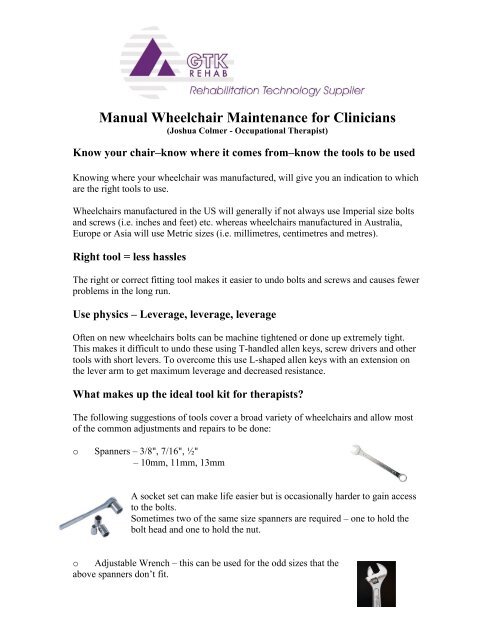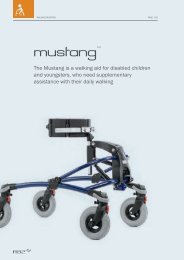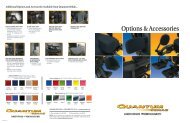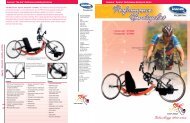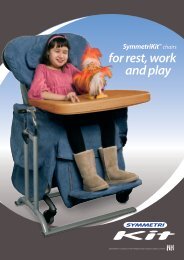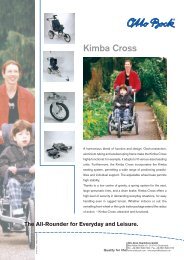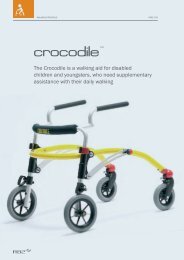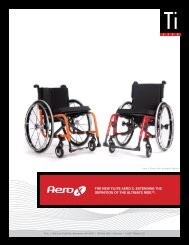Manual Wheelchair Adjustment Guide - GTK Rehab
Manual Wheelchair Adjustment Guide - GTK Rehab
Manual Wheelchair Adjustment Guide - GTK Rehab
Create successful ePaper yourself
Turn your PDF publications into a flip-book with our unique Google optimized e-Paper software.
<strong>Manual</strong> <strong>Wheelchair</strong> Maintenance for Clinicians(Joshua Colmer - Occupational Therapist)Know your chair–know where it comes from–know the tools to be usedKnowing where your wheelchair was manufactured, will give you an indication to whichare the right tools to use.<strong>Wheelchair</strong>s manufactured in the US will generally if not always use Imperial size boltsand screws (i.e. inches and feet) etc. whereas wheelchairs manufactured in Australia,Europe or Asia will use Metric sizes (i.e. millimetres, centimetres and metres).Right tool = less hasslesThe right or correct fitting tool makes it easier to undo bolts and screws and causes fewerproblems in the long run.Use physics – Leverage, leverage, leverageOften on new wheelchairs bolts can be machine tightened or done up extremely tight.This makes it difficult to undo these using T-handled allen keys, screw drivers and othertools with short levers. To overcome this use L-shaped allen keys with an extension onthe lever arm to get maximum leverage and decreased resistance.What makes up the ideal tool kit for therapists?The following suggestions of tools cover a broad variety of wheelchairs and allow mostof the common adjustments and repairs to be done:o Spanners – 3/8", 7/16", ½"– 10mm, 11mm, 13mmA socket set can make life easier but is occasionally harder to gain accessto the bolts.Sometimes two of the same size spanners are required – one to hold thebolt head and one to hold the nut.o Adjustable Wrench – this can be used for the odd sizes that theabove spanners don’t fit.
o Allen Keys – 1/8", 5/32", 3/16"– 3mm, 4mm, 5mmT-handled allen keys are great for quick adjustments but havevery little leverage for tight, stubborn bolts. They also limitaccess to awkward screws and bolts, whereas L-shaped allenkeys give you good leverage for tight bolts and you can useeither end of the allen key. They are generally purchased in a setso you have just about all the options covered.oScrewdriver – Phillips Head– Flat HeadoStanley KnifeoSticky back Velcro – enough saidCommon adjustments to wheelchairs and their clinical implicationsAdjusting the rake/dump/seat to floor heights on a manual wheelchair- Front Seat to floor heightOverall height for transfersPressure redistribution on thighs and ITsChanges Rake – impact on hip angleChanges back angleCastor angle- Rear seat to floor heightOverall height of user – function and environmentPressure redistribution on IT’s and thighsShoulder position in relation to rear wheelsCOG & StabilitySliding side to side transfersCastor angleSitting posture
Change the castor angleWrong castor angle = Poor performance = Extra strain on shoulders and difficultypushingDecreases manoeuvrabilityDangerous at high speedsAdjust the centre of gravity on a wheelchairIncrease manoeuvrabilityDecrease strain on shouldersIncrease ‘tippiness’Dependent on sitting balanceConsider extras/additions usually on wheelchairDecrease overall footprint/wheelbase of wheelchair (can make it harder to get upcurbs/gutters)Body dimensions (weight distribution)Seat depth/frame lengthAdjust the camber anglesManoeuvrabilitySpeedBase widthRear wheel spacingDoorway widthsWhere did I go wrong and what do I do now – Common problemsUsing incorrect size of allen key, spanners, wrenches and even screwdriversThis can result in the stripping of bolt heads, allen key bolts and screws especially ontight critical bolts. If the bolt is completely stripped and is impossible to remove its timeto call in the service team because the bolt will need to be cut off or drilled out.Not using advantages at our disposalConsider the tools that you are using and if they are offering you the greatest physicaladvantage. Use long levers and the right fitting tool – Work smarter not harder.Adjusting clamp style attachmentsPredominantly seen in brake assemblies, a common mistake is to undo one of the twobolts a majority of the way – this creates an additional force on the second bolt andmakes it extremely hard to remove (even if you use the right size tool and an appropriatesize lever). In this case tighten the first bolt and undo the two bolts at the same time(about ½ a turn each bolt) until both have loosened.Bolts into threaded vs smooth holesIf screwing into threaded holes ensure bolt is tightened prior to attaching nut andtightening that.


